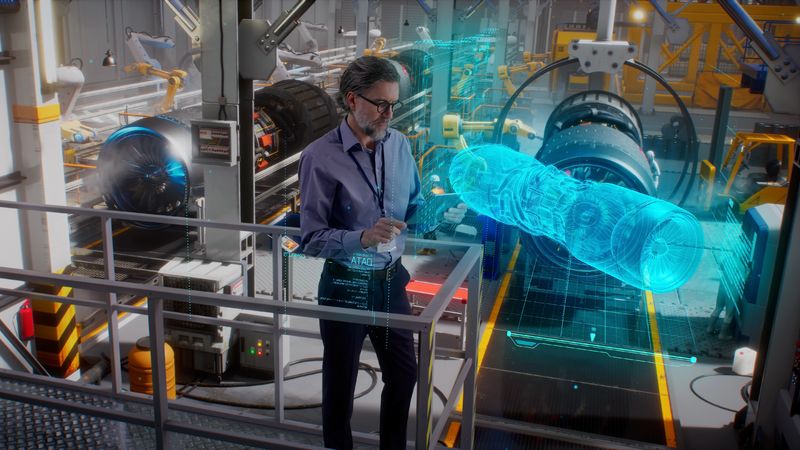Harnessing the Power of Digital Twins for Seamless Digital Thread Integration
Bridging Design and Production: Why Digital Twin and Thread Are Vital for Aerospace Innovation
As aerospace and defense manufacturing targets higher precision and efficiency, digital twin and digital thread technologies are quietly reshaping how products move from design to the real world. These advancements enable companies to bridge the gap between design and production, driving down cycle times while improving innovation, safety, and adaptability. With the aerospace and defense (A&D) sector transitioning to digital-first methodologies, the need for seamless integration of these technologies has never been more critical.
A&D manufacturers today must meet tighter production schedules, ensure greater accuracy, and create systems that can evolve in real time to changing conditions. Digital twins and digital threads serve as a single source of truth, ensuring interoperability across the lifecycle of each asset—from requirements capture to assembly and certification. In this context, these technologies are pulling the strings to improve operational efficiency and deliver data-driven insights. Companies that embrace these tools are positioning themselves to lead the next generation of A&D engineering.
Digital Twin and Digital Thread in Aerospace and Defense
The A&D sector stands to benefit greatly from innovations like digital twins and digital threads, especially with its demand for precision and safety. As A&D products shifts towards mechatronics, digital twins allow system integration across mechanical, electronic, and software components, capturing real-time data to provide actionable insights into performance and condition. This helps implement smart manufacturing, remote asset monitoring, robust configuration & traceability, predictive maintenance, reducing unplanned downtime and extending equipment lifespan.
Model-Based Systems Engineering (MBSE) frameworks combined with digital threads help to standardize workflows from CAD/CAE to CAM/CMM, supporting both new product introduction and industrialization. In defense, digital twins allow for real-time operational readiness assessments of critical assets like fighter jets, naval vessels, and unmanned systems, while digital threads ensure system integrity and a continuous data flow across the entire lifecycle—from mission planning to post-deployment sustainment.
These technologies are applicable across multiple domains—land, air, maritime, and space—to optimize design, improve maintenance, and ensure peak performance in all environments. They also support the global nature of defense contracts, with embedded Product Manufacturing Information (PMI) and annotations overcoming language barriers in multinational operations.
As companies look to optimize performance and reduce cycle times, adopting these technologies is helping them achieve significant operational improvements, thus creating more cohesive, data-driven systems for better decision-making and long-term sustainability.
Watch It On-Demand: Unlocking the Power of Digital Twins for Aerospace Manufacturing
Now available on-demand, “Unlocking the Power of Digital Twins for Aerospace Manufacturing” provides valuable insights into how these transformative technologies are reshaping the industry. Access now:
Industry Insights: Driving Innovation through Digital Integration
Quest Global has worked across various A&D projects, helping companies integrate digital thread strategies to accelerate timelines and enhance efficiency. In the defense space, this integration enables complex systems, such as military aircraft and missile defense platforms, to move seamlessly from concept to deployment while maintaining mission-critical performance and security. By digitizing Standard Operating Procedures (SoPs) and augmenting them with simulations through Virtual Reality (VR) and Augmented Reality (AR), digital twins streamline production and enable maintenance, repair, and overhaul (MRO) with enhanced accuracy.
In a project with a leading aeroengine OEM for the US Department of Defense (DoD), Quest Global’s design thread expertise, particularly in MBSE, was critical in connecting systems architecture and accelerating the design process. In another project, they helped reduce manufacturing design cycle times by 30% using adaptive closed-loop manufacturing, predictive analytics, and supply chain connectivity. This digital twin initiative improved the overall efficiency by 44%, demonstrating the power of real-time simulations and predictive analytics in reducing non-conformance and optimizing manufacturing.
The Industry-Wide Impact of Digital Twin and Digital Thread Technologies
Digital twins and digital threads enable companies to create continuous, data-driven feedback loops that enhance decision-making, streamline operations, and reduce inefficiencies and complexities. By embedding real-time insights into their processes, A&D manufacturers can optimize performance at every stage of the product lifecycle, from design to production and maintenance.
Digital twins, in particular, allow manufacturers to simulate different scenarios and test outcomes without needing physical prototypes. This helps reduce risk, accelerate time-to-market, and improve overall system reliability. With digital twins, we’re seeing a shift from reactive to proactive management in aerospace manufacturing. It goes beyond preventing failures toward continuously improving processes, shortening design cycles, and enabling adaptive manufacturing that responds in real time to operational data.
Meanwhile, digital threads ensure that data remains connected and accessible throughout the entire lifecycle, bridging gaps between traditionally siloed systems. This interconnectedness fosters collaboration and allows for more informed decision-making, helping companies meet the growing demands for efficiency, sustainability, and speed. In A&D, real-time data integration supports faster response times and optimizes product performance under changing geopolitical scenarios, empowering OEM’s & Global Supply chain to maintain readiness in dynamic environments. Digital manufacturing and Industry 4.0 technologies also foster increased awareness and improvement toward Health and Social care (HSC).
As the A&D industry embraces digital technologies, manufacturers are empowered to optimize their operations and properly position themselves to innovate and adapt to future challenges, laying the groundwork for smarter, more responsive manufacturing ecosystems.

